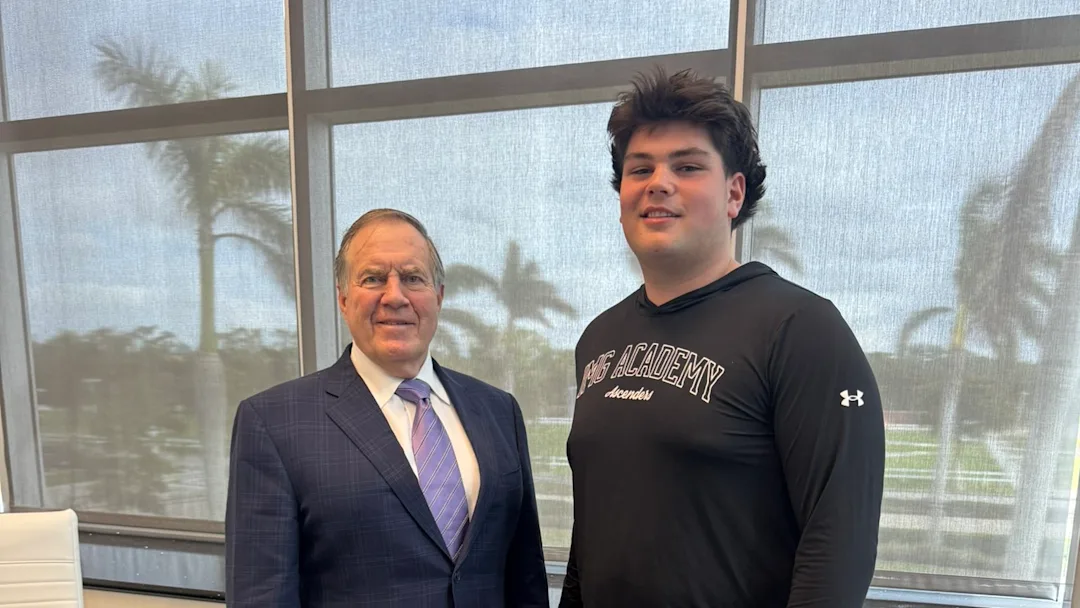Oklahoma’s football program was dealt a significant setback this week as one of its prized offensive line prospects announced he was flipping his commitment to the University of North Carolina, sending shockwaves through the recruiting landscape and raising fresh questions about the Sooners’ 2025 recruiting class. The unexpected decision came after months of optimism in Norman, where the coaching staff believed they had secured a cornerstone for the future of their offensive line. Now, that foundation is suddenly uncertain, and North Carolina is celebrating a major coup in its quest to compete among the nation’s elite programs.
The offensive lineman in question had been one of the most heavily recruited trench players in the country. A dominant force in high school, he had impressed scouts and coaches alike with his blend of size, strength, and athleticism. At 6-foot-6 and over 300 pounds, he anchored his team’s offensive front with poise, regularly dominating top-tier defensive competition and displaying a football IQ well beyond his years. Oklahoma fans were understandably thrilled when he initially pledged to the Sooners, viewing his commitment as a testament to the program’s ability to attract national talent and develop elite linemen for the next level.
However, as recruiting often goes, verbal commitments are only as strong as the relationships behind them. Over the past several weeks, North Carolina ramped up its pursuit. Tar Heels head coach Mack Brown and his staff made the offensive lineman a top priority, scheduling multiple visits and maintaining consistent contact with both the player and his family. Sources close to the recruitment suggest that Chapel Hill’s emphasis on academics, early playing time, and the opportunity to be part of something special in the ACC all factored heavily into the decision to flip.
For Oklahoma, the loss is not just about one player—it’s about momentum. In the hypercompetitive world of recruiting, perception matters. The Sooners have been working to reestablish themselves as a perennial contender following their move to the SEC, and losing a top offensive lineman to an ACC school, even one with a growing national profile like North Carolina, doesn’t help the narrative. Especially for offensive line coach Bill Bedenbaugh, regarded as one of the best in the business, this decommitment stings. His track record of sending linemen to the NFL is widely respected, and the Sooners had hoped that would be enough to secure long-term commitment.
What made this particular flip even more surprising was the player’s public affirmation of his commitment to Oklahoma just weeks prior. He had spoken highly of the Sooners’ facilities, culture, and coaching staff. Fans and analysts alike took him at his word. But the recruiting trail is rarely linear, and the tides shifted quickly once North Carolina doubled down on their efforts. The visit to Chapel Hill was described as a game-changer by those close to the situation. The offensive lineman came away impressed not just by the campus and coaching staff, but by the program’s long-term vision and sense of family.
From North Carolina’s perspective, this is a massive recruiting win. The Tar Heels have been aggressive in targeting top-tier talent from outside their traditional footprint, and this commitment signals a growing confidence in their ability to win national battles. The offensive line has long been an area of focus for North Carolina, and securing a player of this caliber is a major boost to their trenches. It also sends a message to other recruits that the Tar Heels are building something real—and that they can go toe-to-toe with SEC powerhouses and come out on top.
Recruiting experts noted that this commitment flip also underscores the increasing volatility of the modern recruiting environment. With NIL deals, increased transfer flexibility, and greater media attention than ever before, young athletes are navigating a high-stakes decision-making process. Commitments made during junior or even early senior years are often revisited as signing day approaches, and players are more empowered to make late changes if they believe another school presents a better opportunity. For Oklahoma, that means continuing to recruit aggressively all the way to the finish line—and perhaps reassessing how they close on elite prospects.
This development also puts added pressure on Oklahoma’s staff to solidify the rest of their offensive line class. While the Sooners still have several promising linemen on their radar and in the fold, losing a headliner can create ripple effects. Other programs may now intensify their efforts to poach Oklahoma commits, sensing vulnerability. It becomes imperative for the Sooners to reaffirm their relationships with current pledges and show tangible signs of progress as the season approaches.
Fan reaction to the decommitment was swift and mixed. Some expressed frustration with the player, accusing him of wavering or chasing attention. Others were more understanding, acknowledging the difficulty of the decision and pointing to the broader challenges facing modern college programs trying to keep commitments firm. Most, however, agreed that this was a loss—one that will require a strong rebound on the recruiting trail and possibly even adjustments to how Oklahoma sells its program in an increasingly crowded marketplace.
At the same time, there is still a long way to go until National Signing Day. The recruiting landscape is fluid, and nothing is finalized until the paperwork is signed. It’s possible, though not necessarily probable, that Oklahoma could remain in the picture or that other programs could enter the fray. But for now, North Carolina is celebrating a win, and Oklahoma is left reassessing its strategy.
The Sooners’ move to the SEC has brought a new level of scrutiny and competition. The program is no longer just competing with Texas, Oklahoma State, and the rest of the Big 12—it’s now battling Alabama, Georgia, LSU, and other national powerhouses for recruits. Every win or loss on the trail is magnified, and every top-100 prospect becomes a symbol of a program’s direction. That’s what makes this flip so painful for Oklahoma and so meaningful for North Carolina.
What happens next will depend on how each program responds. For Oklahoma, the focus will turn to shoring up their class and preventing further erosion. The coaching staff has shown they can respond to adversity before, and it’s likely they’ll be aggressive in pursuing late-cycle risers or transfer portal options. North Carolina, meanwhile, will look to use this win as a springboard. Landing a top-tier offensive lineman from SEC territory is no small feat, and it could help open the door for other elite recruits who now view the Tar Heels as a legitimate destination.
Ultimately, recruiting is a long game. One player does not define a class, and one flip does not determine a program’s future. But moments like this matter. They shape narratives, build momentum, and influence decisions across the country. For Oklahoma, this was a gut punch. For North Carolina, it was a resounding statement. Both programs will move forward, but only one is celebrating today. The battle for the nation’s top talent continues, and with signing day still ahead, the twists and turns are far from over.



